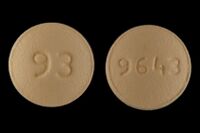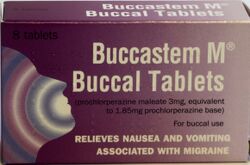Prochlorperazine
| Summary sheet: Prochlorperazine |
| Prochlorperazine | |||||||||||||||||||||||
|---|---|---|---|---|---|---|---|---|---|---|---|---|---|---|---|---|---|---|---|---|---|---|---|
| Chemical Nomenclature | |||||||||||||||||||||||
| Common names | Compazine, Stemzine, Buccastem, Stemetil, Phenotil | ||||||||||||||||||||||
| Systematic name | 2-chloro-10-[3-(4-methyl-1-piperazinyl)propyl]- 10H-phenothiazine | ||||||||||||||||||||||
| Class Membership | |||||||||||||||||||||||
| Psychoactive class | Antipsychotic | ||||||||||||||||||||||
| Chemical class | Phenothiazine | ||||||||||||||||||||||
| Routes of Administration | |||||||||||||||||||||||
|
|||||||||||||||||||||||
| Interactions | |||||||||||||||||||||||
Prochlorperazine (Compazine, Stemzine, Buccastem M, Stemetil, Phenotil) is a dopaminergic D2 receptor antagonist that belongs to the phenothiazine class of antipsychotic agents that are used for the treatment of nausea and vertigo. It is also a highly potent typical antipsychotic and is 10–20× more potent than chlorpromazine. It is also used to treat migraine headaches.[1]
Chemistry
Prochlorperazine is a piperazine derivative of the phenothiazine class of organic compounds. Prochlorperazine contains a thiazine ring, a six-member ring which includes one nitrogen and one sulfur atom. The thiazine ring is fused to two benzene rings, creating a tricyclic phenothiazine. Prochlorperazine contains a chlorine atom bound to R2 of the phenothiazine group.
Additionally, there is a three carbon propyl chain bound at R10 to the nitrogen atom of the structure. The propyl chain is bound at its terminal carbon to a piperazine ring at R1. Piperazine is a six-membered saturated ring with two nitrogen atoms at positions 1 and 4. The piperazine ring of prochlorperazine is also substituted at R4 with a methyl group. Prochlorperazine is found in pills as a maleate. It is analogous to chlorpromazine, another antipsychotic phenothiazine.
Pharmacology
Prochlorperazine is thought to exert its antipsychotic effects by blocking dopamine receptors.[2]
Prochlorperazine is analogous to chlorpromazine; both of these agents antagonize dopaminergic D2 receptors in various pathways of the central nervous system. This D2 blockade results in antipsychotic, antiemetic and other effects.
Subjective effects
Disclaimer: The effects listed below cite the Subjective Effect Index (SEI), an open research literature based on anecdotal user reports and the personal analyses of PsychonautWiki contributors. As a result, they should be viewed with a healthy degree of skepticism.
It is also worth noting that these effects will not necessarily occur in a predictable or reliable manner, although higher doses are more liable to induce the full spectrum of effects. Likewise, adverse effects become increasingly likely with higher doses and may include addiction, severe injury, or death ☠.
Cognitive effects 
- The general head space of prochlorperazine is often described as one of sleepiness, emptiness, apathy, stupor and catatonia. The specific cognitive effects can be broken down into several components which progressively intensify proportional to dosage. These are described below and generally include:
Toxicity and harm potential
Nervous system side effects have been associated with the use of prochlorperazine. Extrapyramidal side effects such as acute dystonic reactions, pseudoparkinsonism (not to be confused with Parkinson's disease), or akathisia can affect 2% of patients at low doses, whereas higher doses may affect as many as 40% of patients.[3][4]
Prochlorperazine can also cause a life-threatening condition called neuroleptic malignant syndrome (NMS). Some symptoms of NMS include a high fever, stiff muscles, confusion, irregular pulse or blood pressure, a fast heart rate (tachycardia), sweating, or irregular heart rhythms (arrhythmias).
Lethal dosage
The lethal dosage of this compound is unknown. Symptoms of overdose, however, may include agitation, coma, confusion, difficulty breathing, fainting, irregular heartbeat, loss of consciousness, muscle spasms, uncontrolled muscle movements, restlessness, seizures, severe constipation, stomach pain, severe drowsiness, dizziness, tremors, or trouble urinating.
It is strongly recommended that one use harm reduction practices when using this drug.
Tolerance and addiction potential
As with other antipsychotics, dependence can be present with long-term use and is both physical and psychological dependence. When physical dependence has developed, withdrawal symptoms may occur if a person suddenly stops their usage.
Legal status
- Australia: The substance is Schedule 3, meaning it is available with the advice of a pharmacist without a prescription.[citation needed]
- United Kingdom: The drug is available over the counter as a pharmacy medicine and as a prescription medication. The OTC brand is Buccastem M, a buccal delivery system of prochlorperazine for motion sickness or nausea.[5]
- United States: Prochlorperazine is available only through prescription.[citation needed]
See also
External links
References
- ↑ Husseini, A; Gianakos, D (February 2006). "The 15-Minute Visit". Patient Care 40: 9–10.
- ↑ Ebadi, M. (31 October 2007). Desk Reference of Clinical Pharmacology. CRC Press. ISBN 9781420047448.
- ↑ Brown, T. M., Stoudemire, A. (1998). Psychiatric Side Effects of Prescription and Over-the-counter Medications: Recognition and Management. American Psychiatric Pub. ISBN 9780880488686.
- ↑ http://www.drugs.com/sfx/procot-side-effects.html
- ↑ Package leaflet: Information for the user. Buccastem® M Buccal Tablets (PROCHLORPERAZINE MALEATE 3 MG, EQUIVALENT TO 1.85 MG PROCHLORPERAZINE BASE) Alliance Pharmaceuticals, LTD. (2016)
 Buccastem M use guide, last revised in January 2016.
Buccastem M use guide, last revised in January 2016.

